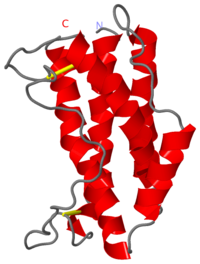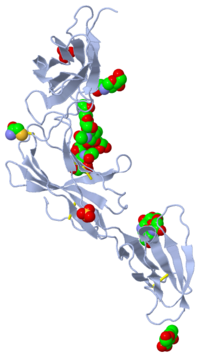Sandbox Reserved 162
From Proteopedia
| Line 3: | Line 3: | ||
__TOC__ | __TOC__ | ||
== Background == | == Background == | ||
| - | Human Interleukin-6 (IL-6) is a immune protein often categorized under [[hematopoietins]]. Since its discoverey, it has been known by many names including: interferon-ß2 (IFN-ß2), 26-kD protein, B-cell stimulatory factor-2 (BSF-2), hepatocyte stimulating factor (HSF), cytotoxic T-cell differentiation factor (CDF), interleukin-HP1 (IL-HP1), monocyte-granulocyte inducer type 2 (MGI-2), and hybridoma/plasmacytoma growth factor (HPGF/HGF). It wasn't until December of 1988 that is was givin the final moniker of IL-6 (PDB: 1IL6). The protein encoded by this gene is a subunit of the receptor complex for IL6. | + | Human Interleukin-6 (IL-6) is a immune protein often categorized under [[Wikipedia:hematopoietins|hematopoietins]]. Since its discoverey, it has been known by many names including: interferon-ß2 (IFN-ß2), 26-kD protein, B-cell stimulatory factor-2 (BSF-2), hepatocyte stimulating factor (HSF), cytotoxic T-cell differentiation factor (CDF), interleukin-HP1 (IL-HP1), monocyte-granulocyte inducer type 2 (MGI-2), and hybridoma/plasmacytoma growth factor (HPGF/HGF). It wasn't until December of 1988 that is was givin the final moniker of IL-6 (PDB: 1IL6). The protein encoded by this gene is a subunit of the receptor complex for IL6. |
== Structure == | == Structure == | ||
| Line 9: | Line 9: | ||
== Functions == | == Functions == | ||
| - | Interleukin 6 (IL6) is a potent polyfunctional [[cytokine]] that plays a vital role in host defense. This is demonstrated by its potent ability to induce acute-phase responses in the liver. | + | Interleukin 6 (IL6) is a potent polyfunctional [[Wikipedia:cytokine|cytokine]] that plays a vital role in host defense. This is demonstrated by its potent ability to induce acute-phase responses in the liver. |
== IL-6 Receptor == | == IL-6 Receptor == | ||
Revision as of 19:34, 26 March 2011
|
Contents |
Background
Human Interleukin-6 (IL-6) is a immune protein often categorized under hematopoietins. Since its discoverey, it has been known by many names including: interferon-ß2 (IFN-ß2), 26-kD protein, B-cell stimulatory factor-2 (BSF-2), hepatocyte stimulating factor (HSF), cytotoxic T-cell differentiation factor (CDF), interleukin-HP1 (IL-HP1), monocyte-granulocyte inducer type 2 (MGI-2), and hybridoma/plasmacytoma growth factor (HPGF/HGF). It wasn't until December of 1988 that is was givin the final moniker of IL-6 (PDB: 1IL6). The protein encoded by this gene is a subunit of the receptor complex for IL6.
Structure
This structure of Interleukin-6 was crystallized at 1.9Å. IL-6 is a monomer of 185 amino acids produced from T-Cells, macrophages, and endothelial cells found on a single gene at locus 7p21. It contains five alpha-helices and four of these helices constitute a classical four-helix bundle with the fifth helix located in the CD loop. The four helices that form the four-helix bundle are arranged so that two helices (A & B) run in the same direction and two (C & D) in the opposite direction. The N-terminal 18 amino acids of IL-6 are not visible in electron density maps and consequently have not been modeled. The first long helix (A) extends from Ser21 to Ala45 and is connected to a parallel helix (B) by a 25 amino acid loop. This helix (B) extends from Glu80 to Gln102. A short connection formed from Asn103 to Ser108 joins this helix to the next helix (C). This third helix extends from Glu109 to Lys129 and is followed by another amino acid loop which includes a short helix of three turns (Pro141-Gln152). The last helix (D) extends from Gln156 to Arg182.
Functions
Interleukin 6 (IL6) is a potent polyfunctional cytokine that plays a vital role in host defense. This is demonstrated by its potent ability to induce acute-phase responses in the liver.
IL-6 Receptor
|
Clinical Applications
Dysregulated production of IL6 and this receptor are implicated in the pathogenesis of many diseases, such as multiple myeloma, autoimmune diseases and prostate cancer. Alternatively spliced transcript variants encoding distinct isoforms have been reported. A good correlation has been found between levels of IL-6 and bone loss in patients with Paget's disease and multiple myeloma. In those patients, higher levels of IL-6 correlated to higher rates of bone loss. Additionally, IL-6 levels decreased with increasing levels of estrogen. These findings strongly suggest that IL-6 plays a key roll in post-menopausal bone loss.


